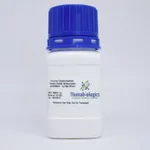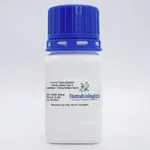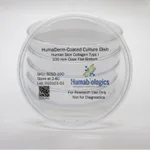
Humabiologics Huma OsteoGelatin- Human Gelatin, Lyophilized, High Bloom ~300g (BGHL)
✨AI 추천 연관 상품
AI가 분석한 이 상품과 연관된 추천 상품들을 확인해보세요
연관 상품을 찾고 있습니다...


Huma OsteoGelatin- Human Gelatin, Lyophilized, High Bloom ~300g (BGHL)
Huma OsteoGelatin, High Bloom is ideal for coating tissue culture surfaces with a thin layer of gelatin to support rapid cell attachment and growth or for hydrogel application. Humabiologics offers the first and only human gelatin in the market derived from bone at Bloom numbers between 90-300 g to meet translation research and regenerative therapies needs.
Gelatin has been used for generation of tissue-engineered scaffolds and can be combined with other human-derived biomaterials -such as Collagen Type I from human skin (HumaDerm offered by Humabiologics) – to make completely human-derived tissue engineered composites.
Product Description
Gelatin is a heterogenous mixture of water-soluble proteins with high average molecular masses. Gelatin proteins are derived by denaturing collagen-rich tissue in water [1]. The mechanical properties of gelatin, such as gel stiffness and compressibility, are related to the average molecular weight of the gelatin proteins and characterized by its Bloom number [2]. Humabiologics offers the first and only human gelatin in the market derived from bone at Bloom numbers between 90-300 g to meet the needs of translational research and regenerative therapies. Bloom is proportional to the average gelatin molecular mass.
Due to its excellent biocompatibility, gelatin has been used to generate 3D scaffolds and hydrogels for tissue engineering applications [4], and as a delivery material to control the release of bioactive molecules [5]. In the pharmaceutical industry, gelatin is used as an encapsulating agent and binder for tablet production [6]. Gelatin can be combined with other human-derived biomaterials- such as Collagen Type I from human skin (HumaDerm offered by Humabiologics) – to make completely human-derived tissue engineered composites [7].
Huma OsteoGelatin, High Bloom is ideal for coating tissue culture surfaces with a thin layer of gelatin to support rapid cell attachment and growth or for hydrogel application. The optimal gelatin concentration used may vary depending on cell type or experiment and must be titrated for best results.
Tissue Source
Huma OsteoGelatin is extracted and purified from human bone sourced strictly from American Association of Tissue Banks (AATB) accredited and FDA registered tissue banks and organ procurement organizations (OPOs). Humabiologics strives to meet research needs by providing high quality biomaterials obtained from tissue partners who comply with requirements for transplantable human tissues under 21 CFR 1271 of the Food and Drug Administration (FDA).
Precautions and Disclaimer
Huma OsteoGelatin is obtained from human tissue that has been tested and found negative for a minimum of HIV-1 and -2, hepatitis B, and hepatitis C, as well as other infectious agents. Please review the Safety Data Sheet (SDS) for information regarding hazards and safe handling practices. Huma OsteoGelatin is for research use only and is not intended for human use, diagnosis, screening, household, food or other uses.
Storage/Reconstitution
This product can be stored in airtight containers at ambient temperature (15-30 °C) upon receipt and prior to solubilization. Research grade products have a shelf life of 6 months after opening.
Huma OsteoGelatin can be reconstituted in 37 °C water or PBS to the desired concentration with agitation/vortexing for several minutes. Dissolving time depends on the gelatin concentration but usually takes a few minutes for low concentration. Centrifugation might be used to remove undissolved particulate. After reconstitution, solution should be used immediately or stored at 2-10 °C. Solubilized gelatin can be sterilized by filtration through a 0.22 µm membrane.
Preparing Gelatin-Coated Tissue Cultureware
Note: The following are general recommendations. Researcher should optimize parameters based on their specific applications. Optimal gelatin concentrations for tissue culture surface coatings may depend on application and cell type and must be determined for each application. Typically, 100-1000 µg/ml of gelatin is used. We recommend making a 1 mg/ml stock solution, but concentration can be increased or decreased based on cell type and application.
Dissolve Huma OsteoGelatin in DI water to the desired concentration (i.e.,1 mg/ml). Gelatin should readily dissolve with agitation. Higher concentration may require heating to 37 °C with gentle agitation for 30 minutes to ensure complete dissolution.
Sterilize the solubilized gelatin by filtering through a sterile 0.22 µm filter or by autoclaving at 121°C for 15 minutes. Coatings and thin membranes may be sterilized under UV in the biosafety cabinet for 30 minutes.
Aseptically add gelatin solution to tissue culture surface to evenly cover entire surface.
Cover and incubate gelatin coated surfaces at 37 °C for 2 hours. The optimal incubation time may vary depending on the experiment and cell type and should be determined for each application.
Transfer gelatin coated surfaces to biosafety cabinet and aspirate excess solution from coated surface careful not to scratch the surface. Remove lid to allow for air drying overnight.
Use gelatin coated cultureware immediately or keep sterile and store at 2-10 °C.
References
Gelatin Manufacturers Institute of America Inc, Gelatin Handbook. 2012: 51 W 52nd St, New York, New York 10019, US.
Gelatin Manufacturers Institute of America Inc, Standard Methods for the Sampling and Testing of Gelatins. 1986: 51 W 52nd St, New York, New York 10019, US.
Davidenko, N., et al., Evaluation of cell binding to collagen and gelatin: a study of the effect of 2D and 3D architecture and surface chemistry. J Mater Sci Mater Med, 2016. 27(10): p. 148.
Kang, H.W., Y. Tabata, and Y. Ikada, Fabrication of porous gelatin scaffolds for tissue engineering. Biomaterials, 1999. 20(14): p. 1339-44.
Dong, Z., Q. Wang, and Y. Du, Alginate/gelatin blend films and their properties for drug controlled release. Journal of Membrane Science, 2006. 280(1): p. 37-44.
Corveleyn, S. and J.P. Remon, Formulation and production of rapidly disintegrating tablets by lyophilisation using hydrochlorothiazide as a model drug. International Journal of Pharmaceutics, 1997. 152(2): p. 215-225.
Gautam, S., et al., Surface modification of nanofibrous polycaprolactone/gelatin composite scaffold by collagen type I grafting for skin tissue engineering. Materials Science and Engineering: C, 2014. 34: p. 402-409.
🏷️Humabiologics 상품 둘러보기
동일 브랜드의 다른 상품들을 확인해보세요

Humabiologics
Humabiologics Huma OsteoGelMA- Human Gelatin Methacrylate, Lyophilized (BMHL/BMML)
1,141,000원

Humabiologics
Humabiologics Huma OsteoGelatin- Human Gelatin, Lyophilized, Medium Bloom ~225g (BGML)
457,000원

Humabiologics
Humabiologics Huma OsteoGelatin- Human Gelatin, Lyophilized, High Bloom ~300g (BGHL)
457,000원

Humabiologics
Humabiologics HumaDerm Coated Culture Dishes, Human Skin Collagen Type I, Clear Flat Bottom (SCSD)
603,000원

Humabiologics
Humabiologics HumaDerm Coated Flasks, Human Skin Collagen Type I, Clear Flat Bottom (SCST)
642,000원
배송/결제/교환/반품 안내
배송 정보
| 기본 배송비 |
| 교환/반품 배송비 |
|
|---|---|---|---|
| 착불 배송비 |
| ||
| 교환/반품 배송비 |
| ||
결제 및 환불 안내
| 결제수단 |
|
|---|---|
| 취소 |
|
| 반품 |
|
| 환급 |
|
교환 및 반품 접수
| 교환 및 반품 접수 기한 |
|
|---|---|
| 교환 및 반품 접수가 가능한 경우 |
|
| 교환 및 반품 접수가 불가능한 경우 |
|
교환 및 반품 신청
| 교환 절차 |
|
|---|---|
| 반품 절차 |
|
